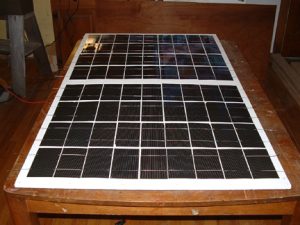
A solar panel is the workhorse of any solar power system. A home solar energy system consists of one or more (usually a goodly number) solar panels plus the wiring and regulatory devices necessary to turn the energy they generate into electric power. The power generated is either used directly in the home or sold to an electric utility through net metering for credit used to buy power later. Whether your system is on or off the grid, the solar panels are the most costly part of the equipment necessary to build your system.
You can save a lot of money on your solar system by installing it yourself rather than hiring a contractor, but even so the cost of the solar panels can run to several thousand dollars for a complete system capable of meeting all your energy needs. But you can shave off a lot of that cost by building your own solar panels from scratch.
Parts For A Solar Panel
A solar panel requires a frame box, a plexiglass cover, solar cells, and wiring. It’s also necessary to have certain tools on hand, including a saw, screwdriver, screws, a soldering iron, and fine grade solder. If you have all these tools on hand already, great; if not, they can be acquired at a hardware store for not too much money. You will also need some adhesive to attach the solar cells to the frame, unless you find and purchase self-
The size of the frame isn’t crucial, but how big it is will determine how many solar cells it can hold and how much electricity each panel will produce. The most common size of solar cell is 100mm x 100mm, generating roughly 1 –
Buying Solar Cells
The best way to get solar cells to make your solar panels is to look for a bargain directly from the manufacturer. You can also sometimes find good deals on EBay or Amazon. If you go to the manufacturers, however, often you can buy cells with cosmetic manufacturing flaws at a discount. These cells perform as well as perfect cells, but they aren’t as pretty. The manufacturer can’t use them in a solar panel for commercial sale, and will probably be happy to sell them to you at a discount.
Plans
You can find plans on line to describe the process of making your own solar panel for less than $50, often for free. The plans should go into details about how to connect your solar cells to each other and how to connect the assembled panel to a home energy system. The remaining tasks involved (constructing the frame and attaching the solar cells to the frame with adhesive) are more intuitive and require less in the way of detailed information.
What Goes Into A Home Solar System?
Besides the solar panels themselves, a solar system for your home will require certain electronic equipment. Much depends on whether you want your system to be on-
If you want to go off-
Which is better? That depends on what you’re looking for and also on where you live and what’s available in that area. In terms of convenience, an on-
The other reason to consider going off-
